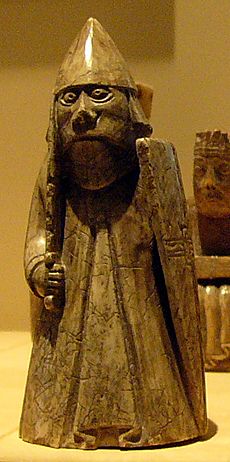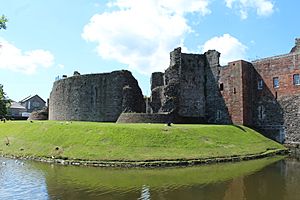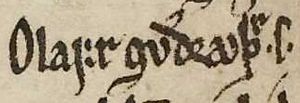Óspakr-Hákon facts for kids
Quick facts for kids Óspakr |
|
|---|---|
| King of the Isles | |

Óspakr's name as it appears on folio 44v of British Library Cotton Julius A VII (the Chronicle of Mann): "Husbac filium Owmundi".
|
|
| Died | 1230 southern Hebrides |
| Burial | Iona |
| House | possibly the Meic Dubgaill dynasty |
| Father | possibly Dubgall mac Somairle |
Óspakr (died 1230), also known as Hákon, was a powerful King of the Isles. He was likely the son of Dubgall mac Somairle, King of the Isles. This made him part of the Meic Dubgaill family, a branch of the larger Meic Somairle group. Óspakr spent much of his life in Norway. He was a member of the Birkibeinar, a group involved in Norway's civil wars.
Óspakr might be the same person as Óspakr suðreyski. This Óspakr was a Birkibeinar who helped raid the Hebrides and Iona around 1209-1210. This attack might have been a way for Norway to show its power over the Kingdom of the Isles.
After the Iona raid, the Kingdom of the Isles faced many conflicts. Two powerful families, the Crovan dynasty, fought for control. Óláfr Guðrøðarson, King of the Isles, became king in 1229. But he still faced strong enemies. These included Alan fitz Roland, Lord of Galloway, and other Meic Somairle leaders.
In 1230, Óláfr fled to Norway. Hákon Hákonarson, King of Norway decided to send a military force to help. He made Óspakr the new King of the Isles. Óspakr was also given the royal name Hákon. He took command of a large fleet heading to the Isles. By May or June, Óspakr's fleet had grown to eighty ships.
Óspakr's forces attacked Bute. They captured a castle there, likely Rothesay Castle, in just a few days. But reports of Alan's nearby fleet made the Norwegians leave Bute. Óspakr died, probably from injuries he got during the Bute attack. After Óspakr's death, Óláfr took charge of the Norwegian mission. He became king on Mann. The next spring, the Norwegians sailed home. King Hákon thanked them for their service. About thirty years later, a man named Ruðri claimed Bute as his birthright. He helped King Hákon in another Norwegian campaign. Ruðri might have been a descendant of Óspakr.
Contents
Óspakr's Family Connections
Óspakr was likely part of the Meic Dubgaill family. This family was a branch of the Meic Somairle group. Specifically, Óspakr seems to have been a son of Dubgall mac Somairle, King of the Isles. Dubgall was the ancestor of the Meic Dubgaill. Dubgall's father was Somairle mac Gilla Brigte, King of the Isles. Somairle was the common ancestor of all the Meic Somairle families.
Even though Óspakr's name sounds Scandinavian, it doesn't mean he wasn't related to the Meic Somairle. Somairle himself had a Gaelic name that came from a Scandinavian one. The Chronicle of Mann says Óspakr's father was Ǫgmundr. But the Hákonar saga Hákonarsonar says Óspakr was the son of Dubgall mac Somairle. If the saga is right, then Ǫgmundr might have been Óspakr's foster father, not his birth father.
The Raid on Iona
Óspakr seems to be the same person as Óspakr suðreyski. This Óspakr was part of a Norwegian force that raided Iona in 1210. According to old Icelandic records, Norway planned a military trip to the Isles in 1209. The next year, Iona was attacked and looted.
Other old stories, called sagas, confirm these events. They say a Norwegian fleet raided the Isles. Men from the Birkibeinar and Baglar groups, who were fighting in the Norwegian civil war, decided to get money by raiding the Isles. They used twelve ships for this. The saga names Óspakr suðreyski as one of the three Birkibeinar leaders of this raid.

This raid might have been Norway's way of showing its power over the Isles. For example, the saga says that a Norwegian fleet landed in Shetland and Orkney. The Bishop of Orkney and the two Earls of Orkney had to go to Norway. They gave hostages and a large payment to Ingi Bárðarson, King of Norway.
The saga also says that two leaders from the Crovan dynasty, Rǫgnvaldr Guðrøðarson, King of the Isles and his son Guðrøðr, also went to Norway. They promised to obey King Ingi and paid him taxes. They received their lands back as a lén (a type of fief, or land given in exchange for loyalty). This shows that Norway was reasserting its authority. The destructive raid on Iona might have been a punishment. It could have been for Rǫgnvaldr not following his duties to Norway, or for him turning towards the English Crown.

The same year as the attack, a bishop named Koli was consecrated for the Isles. This might mean Koli's consecration was linked to the Norwegian trip. The Norwegian mission might have aimed to control both the rulers and church leaders in the Isles. The leaders of the Meic Somairle had recently rebuilt Iona. They had also made it independent from the local church by putting it under the Pope's protection. So, the Norwegian attack on Iona might not have been planned. It could have been an unplanned outbreak of violence during a visit.
Becoming King of the Isles

In the years after the Iona raid, the Kingdom of the Isles was troubled by a fierce conflict. Two leaders from the Crovan dynasty, Rǫgnvaldr and his younger half-brother Óláfr Guðrøðarson, fought for power. Rǫgnvaldr got help from Alan fitz Roland, Lord of Galloway, through a marriage. But Óláfr took control of the Isles in 1226. He killed Rǫgnvaldr three years later.
Alan still had interests in the Isles even after his ally Rǫgnvaldr died. Alan and some Meic Somairle members, like Dubgall and Donnchad (both sons of Dubgall mac Somairle), kept pressuring Óláfr. In the summer of 1229, news of fighting in the Isles reached King Hákon Hákonarson of Norway. The saga says Alan was a main cause of the trouble. It describes him as a "greatest warrior" with many men and ships, raiding the Hebrides.
Dubgall and Donnchad, sons of Dubgall mac Somairle, are also mentioned. Another relative named Somairle is noted too. All three of these Meic Somairle kinsmen are called kings by the saga. It says they were "unfaithful" to the Norwegian Crown. The saga also identifies Óspakr as another son of Dubgall mac Somairle. Óspakr had served outside the Isles as a Birkibeinar for a long time. Óláfr arrived at the Norwegian court in early 1230. He had been forced out of the Isles by Alan and his allies. But King Hákon had already decided what to do.
Several historical records confirm that King Hákon gave the kingship of the Isles to Óspakr. He also gave Óspakr the royal name Hákon. According to the saga, Hákon not only made him king but also gave him command of the Norwegian fleet. This fleet was meant to bring peace back to the Isles. Days after Óláfr arrived in Norway, Óspakr's fleet sailed for the Isles. It grew in size after reaching Orkney.
Once in the Isles, the fleet met up with the three other Meic Somairle members on Islay. The saga says the Meic Somairle held a feast for the Norwegians. That night, while Donnchad slept on board with Óspakr, the Norwegians attacked Dubgall and Somairle. Somairle was killed along with many others. When Óspakr learned of the attack, he let Donnchad escape and protected Dubgall. This might have been to keep the Meic Dubgaill loyal to both Norway and Scotland. Or perhaps Óspakr's Meic Somairle relatives were suspected of trying to ruin the mission. Donnchad later became very loyal to Scotland.
Two important Meic Somairle leaders were missing from Óspakr's campaign. One was Ruaidrí mac Ragnaill. He had been driven from Kintyre by Alexander II, King of Scotland in the 1220s. Ruaidrí might have been involved in another rebellion against the Scottish throne. His younger brother, Domnall, was also not present. This might be because he had made peace with the Scottish king. Domnall owed his land in Kintyre to Alexander's favor. The Norwegian gathering near Islay and the raids in the area might have been Óspakr's way of trying to impress Domnall.

News of the Norwegian fleet quickly reached King Alexander II of Scotland. He went straight to the western coast to deal with the growing crisis. On May 28, Alan fitz Roland was with Alexander II in Ayr. This is where the Scottish royal forces gathered. It was probably May or June when Óspakr's fleet sailed around the Mull of Kintyre. They entered the Firth of Clyde and landed on Bute. There, Óspakr's forces successfully attacked and captured a fortress. This was almost certainly Rothesay Castle.
The sagas say the castle fell after three days of fighting. Three hundred Norwegians and Islesmen died in the attack. By this point, the fleet had grown to eighty ships. This means Óspakr's fighting force might have been over three thousand men. The castle belonged to Walter fitz Alan II, Steward of Scotland. The attack on this stronghold shows how worried the Meic Somairle were about the steward's growing power in the region. The capture of Bute, an important island belonging to a powerful Scottish lord, made the Scots act. Reports that Alan was nearby with a huge fleet forced the Norwegians to retreat to Kintyre. The sagas say Alan's fleet had between 150 and 200 ships. This suggests Alan commanded two to three thousand men.

After the fleet retreated to Kintyre, the saga reports that Óspakr became ill and died. He seems to have died from injuries he got during the attack on Bute. Other records say he was hit by a stone. The Chronicle of Mann says he was buried on Iona. His followers greatly mourned his death.
Óláfr then took command of the fleet. He managed to avoid Alan's forces and took the fleet to Mann for his own purposes. Óláfr was made king again. But he had to share the kingdom with Guðrøðr, who became king in the Hebrides. Guðrøðr had been in Norway before Óláfr arrived. He might have been one of Óspakr's main supporters. King Hákon might have originally planned for Óspakr and Guðrøðr to divide the kingdom, leaving Óláfr out. Or Hákon might have wanted Óláfr and Guðrøðr to share power. He might have promised to help Óláfr if Óláfr gave some power to Guðrøðr.
In any case, the Norwegian forces left Mann for home the next spring. They established Guðrøðr in the Hebrides. But Guðrøðr was killed before the end of 1231. Óláfr then regained control of the entire kingdom. When the Norwegians returned home, the saga says King Hákon's "honours had been won" from the trip. He heartily thanked his men for their service.
Even though Óspakr was made king, it's not clear how King Hákon planned for the Kingdom of the Isles to be governed. Hákon might have intended for Óspakr to rule over the large Meic Somairle lands. This would ensure the family's loyalty to Norway. Óspakr's planned kingdom would have included Argyll, Kintyre, and the Inner Hebrides. If this is true, the fleet's main goal was to secure Óspakr's lands. A secondary goal, decided later, was to restore Óláfr on Mann. Ruaidrí's absence from the campaign might have been because he resented Óspakr's potential rule over him. Scottish records don't mention the Norwegian campaign. But English records, like the Annales de Dunstaplia, show how big it was. They say the Norwegians and Islesmen were only defeated after much effort. They had invaded Scotland and Mann and caused many casualties.
Possible Descendants
In 1263, over thirty years after Óspakr's campaign, Scotland's actions in the Isles led to another Norwegian expedition. This time, King Hákon himself led it. According to the saga, when Hákon reached the southern Hebrides, a ship commander named Ruðri and his two brothers swore loyalty to Hákon. Ruðri claimed Bute as his birthright. He said the Scottish Crown had made him an outlaw for trying to take back what was his. After Hákon's forces raided the island and captured Rothesay Castle, Ruðri killed the Scottish prisoners. He also devastated the Scottish mainland far and wide.
After the campaign, the saga says Hákon rewarded some of his Hebridean followers. He gave Bute to Ruðri. We don't know exactly who Ruðri was, but he could have been a member of the Meic Somairle. He might have been a son or grandson of Óspakr. Or he could have been a descendant of Ruaidrí. If Óspakr was Ruðri's ancestor, then Ruðri's actions on Bute might have been related to the 1230 campaign. He might have been settling old scores. The castle and the town of Rothesay might even be named after Ruðri or one of his ancestors.
As for Óspakr's brothers, Dubgall and Donnchad, we don't know anything more about Dubgall. But Donnchad continued to be an important leader of the Meic Dubgaill into the mid-1200s. He was a powerful lord in Scotland. The fact that he didn't help Óspakr's campaign after being released might show he was trying to balance his family's loyalty to both Norway and Scotland.
Images for kids







